Header logo
header top contact widget
Receded Gums
Connections of Oral Wellness and Overall Health
Posted on Aug 08, 2024 by William J. Claiborne, DDS MS
Over the past few decades, an increased number of studies have pursued the many connections of periodontal (gum) disease and our overall health. With the findings, research has become more focused with links found between infectious oral bacteria and a growing list of serious health problems.
Periodontitis is the most severe form of periodontal disease. It is a severe form of gum infection that damages soft tissues and destroys the bone that supports teeth. This occurs when toxins produced by the bacteria in plaque irritate the gums.
These toxins activate a chronic inflammatory response in which the body, which turns on itself. This systemic inflammation leads to break down and destruction of tissues and bone that support the teeth.
The potent bacteria of gum disease are able to enter the bloodstream through tears in weakened tissues. It is now known that it can trigger inflammatory reactions that are related to the development of the conditions mentioned above. While it can activate the development of serious health problems far beyond the mouth, it can also worsen others already underway.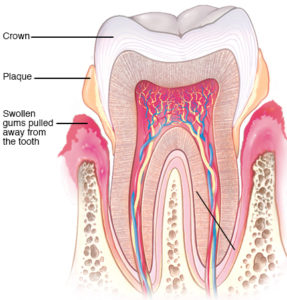
The initial stage of periodontal disease is gingivitis. This may have mild symptoms or even some deemed “normal.” These include areas where the gums are tender or seeing blood in the sink when brushing teeth. However, gingivitis, if not halted, can soon progress to periodontal disease.
Gum disease symptoms include:
• Gums that loosen from teeth (or “recede”)
• Red or swollen gums
• Gums that bleed when flossing or brushing
• Persistent bad breath
• Teeth that may loosen or drift
Without treatment, gum disease worsens. Many people are unaware of the severity of damage capable by these infectious bacteria. Below are some of the correlations that may surprise you.
Using findings from previous research, studies have closely scrutinized two types of oral bacteria pathogens. Researchers found that one pathogen was far more prevalent in the saliva of participants who developed pancreatic cancer with a 59% increased risk of developing the deadly cancer. Just as alarming was that the second pathogen was shown to increase this risk by 50%.
The connections between periodontal disease and other diseases in the body also include a link between oral health and psoriasis. Psoriasis is a chronic disease that affects the skin. Its cause isn’t fully understood but seems to relate to the immune system turning on itself.
This condition causes the life cycle of skin cells to accelerate beyond normal. Cells build up rapidly on the skin’s surface, forming scales and red patches that are often itchy and sometimes painful.
In one study, researchers found that while “people with psoriatic arthritis had about the same rate of gum disease as those without joint inflammation, people with psoriatic arthritis were more likely to have severe gum problems.”
https://www.psoriasis.org/advance/prevention-tips-for-uveitis-stroke-and-gum-disease
Other studies have shown that people with periodontitis (advanced gum disease) are nearly 1.5 times more likely to develop psoriasis than people with healthy gums. Could one trigger the other, and vice versa?
Another study showed that 36% of people with psoriasis had one or more sites of bone loss measuring at least 3 millimeters (over a tenth of an inch). This was compared to 13% of people without psoriasis.
For people who have rheumatoid arthritis (RA), many are learning that research is noting close connections with arthritis and gum disease, too.
RA is a debilitating, painful disease that destroys joints. RA often emerges gradually, initially causing morning stiffness and weak, sore muscles. As inflammation from RA worsens, joints become swollen. Joints become achy and stiff most often in the fingers, wrists, elbows, hips, knees, ankles, toes, and neck. Unfortunately, there is no cure for RA.
Apparently, gum disease and RA share a genetic similarity. The clinical makeup shows similar structures, primarily in pathogens that spark disease or illness. Research has found that the pathological process that occurs in both gum disease and RA are nearly identical.
Both conditions cause chronic inflammation in tissues that connect to bone with both diseases having a similar inflammatory trigger. Even more similar is the particular species of bacteria found in periodontally-diseased tissues when compared with tissues around arthritic joints. In one study, a particular pathogen associated with periodontal disease was found to activate the same destructive process of rheumatoid arthritis.
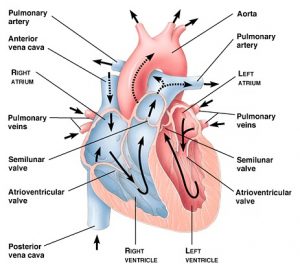 Another example of damage possible by the infectious bacteria of periodontal disease is coronary artery disease. The heart disease connection, as explained by Harvard Medical School’s newsletter, states:
Another example of damage possible by the infectious bacteria of periodontal disease is coronary artery disease. The heart disease connection, as explained by Harvard Medical School’s newsletter, states:
“In people with periodontitis (erosion of tissue and bone that support the teeth), chewing and toothbrushing release bacteria into the bloodstream. Several species of bacteria that cause periodontitis have been found in the atherosclerotic plaque in arteries in the heart and elsewhere. This plaque can lead to heart attack.
“Oral bacteria could also harm blood vessels or cause blood clots by releasing toxins that resemble proteins found in artery walls or the bloodstream. The immune system’s response to these toxins could harm vessel walls or make blood clot more easily. It is also possible that inflammation in the mouth revs up inflammation throughout the body, including in the arteries, where it can lead to heart attack and stroke.”
http://www.health.harvard.edu/press_releases/heart-disease-oral-health
And the list goes on, even including connections between periodontal disease and erectile dysfunction (ED). For men in the 40 – 70 age group, ED affects over 40% with nearly 70% of men at age 70 affected.
One study of 162 males ages 30 to 40 by Turkish researchers, 82 of the participants had normal erection function while 80 who complained of ED, nearly half. Some men in both groups had chronic periodontitis, but the condition was more than twice as prevalent in the ED group.
In another study, 80 male participants who had severe gum disease were more than twice as likely to suffer from erectile dysfunction. This was true even after adjustments were made for other issues that could distort the findings.
Gum disease affects nearly 47% of American adults. It will worsen without treatment and, to no surprise, is the nation’s leading cause of adult tooth loss. As an Asheville periodontal specialist, I have an up-close view of the damaging effects of gum disease.
If you are experiencing signs of gum disease, start with a thorough periodontal examination. Call 828-274-9440 or ask our friendly staff about beginning with a consultation.
If dental fears have caused you to delay or avoid having regular dental care, many treatments can include oral or I.V. sedation (sleep dentistry, or “twilight sleep”).
And, if financial constraints are an obstacle in receiving treatment, we offer several payment plans. Most are interest-free with no down payment required (for qualified individuals). Feel free to ask about these during your consultation.
When Trepidation Keeps You From Going Further For The Smile You Desire
Posted on Jul 31, 2024 by William J. Claiborne, DDS MS
In my 30-plus years as a periodontist in Asheville, I’ve treated hundreds of patients who comes with a variety of needs. Some need treatment that involves the gum tissues, including:
• all stages of gum disease (gingivitis, pregnancy gingivitis, periodontal disease, periodontitis)
• reshaping gum tissues for esthetic enhancement (crown lengthening, correcting ‘gummy smiles’, repairing gum recession)
• diagnosis and placement of dental implants
• treating lesions or cysts in oral tissues
Over the years, I’ve seen adults of all ages who have the ultimate desire for a healthy, confident, and even more attractive smile. While many come to our Western NC periodontal dental office through the referral of their general dentist or another dental specialist, we also see a number who are referred by someone they know (often a past patient) or those who have found us online.
We are happy to welcome all new patients, even those who come to us with trepidation. And, trepidation is something my team and I understand.
While some individuals admit to having dental anxiety or fear, others aren’t in the category of being a fearful patients. Some are holding something in that even they cannot pinpoint, although its a reservation that we can often work through. Their trepidation tends to wane once the patients become more familiar with our skills, technology, and unique features.
To begin, patient comfort is a high priority in our our Asheville periodontal practice. While we are widely known for an environment of comfort and respectful care. This is because, in part, over 70% of the adult population have some level of dental fear or anxiety. The other part is that we would want such an approach to care for ourselves and our loved ones.
For optimal comfort and relaxation, we offer several sedation options, including oral and IV sedation.
• Oral sedation is a pill that helps patients relax. It also has an amnesiac effect, leaving most with little or no memory of treatment afterward.
• I.V. sedation (also known as ‘twilight sleep’) places the patient in a deeper sleep state and erases memory of the procedure. It is administered by a Medical Doctor (MD) who is a board certified Anesthesiologist.
With both sedation options, patients are closely monitored with advanced safety equipment throughout treatment.
We also have a reputation for featuring some of the most advanced technology available, much of which is not available in other dental or periodontal offices in this region. These features help to diagnose with precision, treatment plan with superior accuracy and reduces the patient’s treatment time while optimizing comfort.
Advancements in today’s dental technology are remarkable. Whether the patient’s need is the restoration of gum health or the replacement of missing teeth through dental implants, the advanced skills of a periodontist can help minimize treatment time and complexity of treatment.
In our periodontal dental office, some of the features that help enhance comfort, optimize treatment outcomes, minimize treatment, and speed healing include:
LANAP Protocol Using PerioLase MVP-7: Efficiently and effectively treats periodontitis (advanced gum disease) with laser technology. It causes very little discomfort and has a quick recovery time. This has also been found to stimulate bone regrowth in damaged areas.
Dental Radiology With 3-D Cone Beam Technology: This imaging is ideal for diagnosis and treatment planning. The imaging covers the entire dentition area with clear views of the mandible and maxilla (upper and lower jaw).
CareStream Cone Beam Computer Tomography Imaging: This computerized tomography provides imaging in exceptional detail and range.
CS 3600 intraoral scanner: Patients no longer have to endure having impressions made with bulky, gloopy trays held in their mouths! This quickly and comfortably scans the mouth’s interior for digital impressions using a small, handheld scanner. It can also reach difficult–to–access areas in the patient’s mouth with improved patient comfort.
Simplant Dental Software for Computerized Dental Implant Placement: This system helps in pre-surgical positioning of dental implants on the computer, using a 3D model of the patient’s jaw. This aids in the selection of the implant type that ensures a precision fit.
Intraoral Camera Technology: This provides outstanding quality of images within the mouth. These images are sent to screen for a clear, crisp view so we can confer with patients on specific treatment issues.
Computer Imaging In Treatment Suites: Treatment suites are equipped with computers for convenient image sharing with patients.
Advanced Sterilization: Our custom sterilization unit adheres to (or exceeds) CDC guidelines for instrument processing protocols, particularly in the cleaning of instruments.
Fully-Equipped Surgical Suites: Relax during treatment while surrounded by beautiful mountain views of Asheville.
Once a patient who had reservations understands the amazing environment we offer for their periodontal dental needs, they tend to relax. For those who have periodontal (gum) disease, proceeding with treatment has a more urgent timetable, which has to do with their overall health.
Gum disease is the nation’s leading cause of adult tooth loss. Yet, the bacteria that destroy gums and the structures that support natural teeth don’t always remain confined to the mouth. Through tears in diseased gum tissues, these infectious bacteria can enter the bloodstream.
Once blood borne, the bacteria are able to activate or worsen serious conditions in the human body. Research has correlated oral bacteria to a long list of serious health problems. These include heart disease, stroke, Alzheimer’s disease, arthritis, diabetes, preterm babies, erectile dysfunction (ED), some cancers (including pancreatic), and more.
It is estimated that over 47% of American adults have some level of periodontal (gum) disease. This disease is the nation’s number one cause of adult tooth loss. However, gum health needs to be seen by the general population as a vital player in one’s overall health.
I believe that our population would be more committed to their oral wellness with a more widespread understanding of the hazards of gum disease in the U.S. This is why it is important to be familiar with the signs and symptoms, which include:
• Red, swollen or tender gums or other pain in your mouth
• Bleeding while brushing, flossing, or when eating certain foods
• Gums that are receding (pulling away from the teeth) or make the appear teeth longer than normal
• Loose or separating teeth
• Pus between your gums and teeth
• Sores in your mouth
• Persistent bad breath
• A change in the way your teeth fit together when you bite
• A change in the fit of partial dentures
If you have any of these, you are urged to seek periodontal care as soon as possible. This disease will only worsen without treatment.
There are so many connections between your oral health and your overall health that are yet to be known. Yet, the more research delves into this, the more comes to light. An illustration of this is research at Case Western Reserve University School of Dental Medicine. In this recent study, they found that humans with fewer fat cells are better able to combat periodontal (gum) disease. This is because fat cells trigger inflammation in the body.
In the study, 31 obese people who had clear indications of gum disease were monitored. Half of the group had gastric bypass surgery with fat cells removed from the abdomen. Those in the other group had not had gastric bypass surgery or fat removed.
Researchers noted that the majority of the bypass surgery group had a drop in their glucose levels following the procedure. This is a positive outcome based upon the higher risk of overweight people for diabetes and insulin-related problems.
All study participants underwent non-surgical periodontal treatments and were provided oral hygiene instructions for at-home care. While both groups showed improvement, the surgery group had better results.
https://www.sciencedaily.com/releases/2011/11/111109111540.htm
If you have oral wellness needs, want to replace teeth through dental implants, esthetic goals with the involvement of gum tissues, or have dental fear that has prevented you from receiving regular dental care, let’s sit down together and discuss ways we can help you.
If financial concerns are an issue, we offer several payment plans. These often break treatment fees into monthly payment amounts that are manageable to most budgets. Most have no down payment required and are interest-free.
Call our Asheville periodontal office at: 828-274-9440 and speak with our friendly staff. You can begin with a consultation, if desired.
The “Risk vs. Reward” of Oral Health
Posted on Jun 25, 2024 by William J. Claiborne, DDS MS
Risk versus reward.
This is a phrase that’s often associated with decision-making, such as stock market investments. While certain strategies can increase the potential for “reward,” there is still an element of “risk” in losing part or all of the investment.
As a periodontist in Asheville, I see this in how it relates to decisions in dentistry. This is the case in replacing lost teeth. As a periodontal specialist, I place many dental implants in patients who’ve lost teeth that likely could have been kept had the patient made different decisions.
I also see this is in the decision of patients to have a crown (“cap”) placed on teeth. When a dentist recommends a crown, it is typically to keep the existing tooth structure intact and protected. So, when a tooth that’s been filled and needs yet another filling, the dentist may advise crowning the tooth instead. This preserves the remaining structure by avoiding the “risk” of tooth from breaking off.
Or, when a tooth shows signs of fracture(s), crowning may prevent the tooth from the need for removal. This is because a tooth that eventually breaks below the gum line can no longer be saved. Once removed, tooth replacement brings on an entirely new set of decisions, and costs.
Your general dentist’s goal, like yours, is to help you achieve and maintain a healthy smile. He or she wants you to keep your natural teeth or, if tooth loss does occur, replace them in a way that supports your overall oral health. A periodontist can be a strong team player in this goal.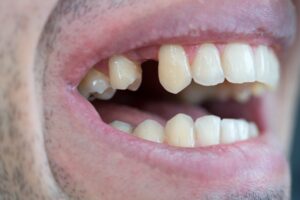
A periodontist is a dentist who specializes in the prevention, diagnosis, and treatment of periodontal disease and in the placement of dental implants. A periodontist is also a specialist in reshaping gum tissues, for reasons that may include esthetics as well as maintaining oral wellness.
I place many dental implants and am a proponent of them as a superior tooth replacement option. However, as ideal as an implant is, there is nothing as good for your oral health as natural teeth. This is why it’s so important to keep them. This may, for certain teeth, require the placement of a crown.
A periodontist may be involved in certain aspects of treatment to optimize a patient’s results and success level while minimizing discomfort. For instance, a periodontist may work with your general dentist to help save a tooth from removal when a tooth has broken close to the gum line. This is accomplished through crown lengthening procedures where gum tissues are removed to expose more of the tooth. This may be able to make sufficient tooth structure available to support a crown.
Crown lengthening is also beneficial in sealing gum tissues surrounding a tooth at its base. By securing the tissue around the tooth or crown, bacterial entry is avoided and the risk for periodontal (gum) disease decreased. This is especially beneficial in cases where gum tissues have receded, exposing sensitive tooth root sections that are easily affected by oral bacteria.
In some cases, gum tissue height can be corrected by careful removal in a procedure known as a gingivectomy. To enhance the appearance of a smile with an esthetically-pleasing smile line, combined with the placement of crowns, the tooth-to-gum ratio is rebalanced.
This is what is often referred to as a “gummy smile.” Crown lengthening is a common method that teams your general dentist with a periodontist to create a smile that looks natural and is beautifully flattering.
Another look at the risk-reward consideration, the “risk” of not caring properly for oral health can easily upend the “reward” of having a healthy smile. Regular dental check-ups and a thorough at-home oral hygiene regimen can prevent the development of cavities and periodontal disease.
When oral bacteria levels in the mouth are not managed, the teeth and gums pay the price, often through the need for costly treatment that may have been prevented. Periodontal disease is the nation’s leading cause of adult tooth loss.
Research has also found that the inflammatory bacteria of gum disease can enter the bloodstream, triggering or worsening a long list of serious health problems. These include heart disease, stroke, high blood pressure, diabetes, arthritis, memory loss, some cancers, impotency and Alzheimer’s disease.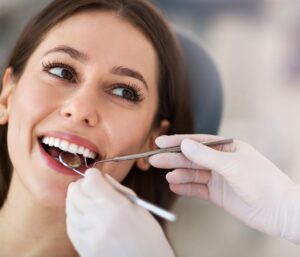
Although gum disease can exist without obvious signs or symptoms, the most commonly noticed are:
• Red, swollen or tender gums
• Seeing blood in the sink when brushing
• Receded gums
• Loose or separating teeth
• Pus pockets on gum tissues
• Sores in the mouth
• Persistent bad breath
As a periodontist in Asheville, we want everyone to know the benefits of a healthy, confident smile. Maintaining healthy gums and keeping your natural teeth is important to every individual.
If your gum health needs improvement or there are signs of gum disease, we can structure a program that restores healthy gums and helps you maintain your oral health between visits.
For those who have already experienced tooth loss, we are happy to discuss the process to replace them with dental implants. These are the closest thing to the natural teeth you had and will restore stability and dependable biting and chewing. Too, dental implants are designed to last a lifetime, making them an excellent investment.
With proper measures, you can enjoy healthy gums and natural teeth throughout your lifetime. Call 828-274-9440 to schedule a periodontal examination or ask for a consultation to get to know us. A referral to our office is not required.
If dental fear or anxiety has kept you from receiving regular dental care, please ask us about oral or I.V. sedation (“twilight sleep”). Both are administered safely with patient comfort always a priority.
What Can A Periodontist Do For You?
Posted on May 13, 2024 by William J. Claiborne, DDS MS
In meeting someone for the first time, a common question is “What do you do?” Telling them that I am a periodontist often gets followed by another question: “What does a periodontist do?” The long version, according to the American Academy of Periodontology, is:
“A periodontist is a dentist who specializes in the prevention, diagnosis, and treatment of periodontal disease, and in the placement of dental implants. Periodontists are also experts in the treatment of oral inflammation. Periodontists receive extensive training in these areas, including three additional years of education beyond dental school. They are familiar with the latest techniques for diagnosing and treating periodontal disease, and are also trained in performing cosmetic periodontal procedures.”
Choosing this dental specialty is achieved by an understanding that it will require many years of education. A periodontist begins by completing 4 years of college (undergraduate training) followed by another 4 years in dental school to earn a doctorate. The periodontal specialty then requires another 3-4 years before completing the stringent requirements for a specialty certification in periodontics.
What can all of this in-depth education and advanced skill level do for you?
Let’s begin with the diagnosis and treatment of all stages of periodontal (gum) disease. According to the Centers of Disease Control & Prevention (CDC), it is estimated that over 47% of Americans have some level of gum disease, which is also the leading cause of tooth loss. That’s nearly half of our population.
In addition to a healthy smile, the health of your gums can impact your overall health. By keeping the bacteria of advanced gum disease, known as periodontitis, you lower your risks of a long list of serious health problems that have been shown connected to gum disease bacteria. These include heart disease, stroke, diabetes, arthritis, Alzheimer’s disease, some cancers, preterm babies, and erectile dysfunction (ED).
A periodontal specialist is also a leading choice in the selection and placement of dental implants. With specialized skills, a periodontist is especially respectful to oral tissues as sensitive layers that have an important role in the appearance of a smile and the health of teeth. Utilizing these skills, a periodontist can help to minimize incisions while effectively treating each area in the mouth.
When it comes to the selection of the implant system best for you, our speciality also understands the complete spectrum of all implant types. Some implant systems offer a non-removable (“fixed”) option with others functioning with removable teeth.
Proper selection of your dental implants can also help to keep treatment fees to a minimum. This is because some implants can support more than one tooth and others are designed to support a full arch of replacement teeth. Because treatment fees are based on the number of implants required, your tooth replacement goals may be within a more manageable budget with fewer implants needed to accomplish your goals.
Reshaping gum tissues is also part of our specialized skills. The gum tissues are designed to provide a tight seal around the base of teeth and block bacterial entry to the sensitive tooth root area. When oral bacteria are able to penetrate beneath the gum line, they can cause inflammation to tender gums and attack the structures that support natural teeth.
In a procedure known as a gingivectomy, we are able to reposition or graft gum tissues over the area of recession to restore a healthy seal and protect the tooth structures below the surface.
In some cases, we are also able to save a natural tooth when the tooth breaks near the gum line. In a procedure known as crown lengthening, a periodontist can sometimes expose enough of the tooth structure for the placement of a crown. By preventing the need for the tooth’s removal, the patient is able to avoid the extensive costs and potential upkeep of replacing it.
When it comes to a smile’s appearance, a periodontist is also the go-to. In smiles that have an uneven line of gum tissues, meaning that some teeth have more gum showing than others. This up-and-down line of gum tissue creates a jumbled look. Crown lengthening can alter the height of these tissues prior to placement of a crown (‘cap’) to provide a more flattering smile line.
Another benefit of the skills of gum recontouring are the correction of a “gummy smile.” In this, the patient has too much gum tissue bordering the tops of teeth, making the smile line unbalanced. Using the gingivectomy procedure, a periodontist can lower the height of gum tissues, which is generally followed by placement of crowns.
Here, our Western North Carolina periodontal dental office features some of the most advanced technology in dentistry. Many of these features are not available in other dental offices elsewhere. Some of these include: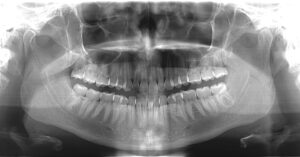
LANAP With PerioLase MVP 7 (Laser-Assisted New Attachment Procedure) – an advanced protocol that efficiently and effectively treats advanced gum disease with the added advantages of a dental laser. This offers a non-surgical alternative for patients with moderate to severe periodontal disease. LANAP treatment has also been found to stimulate bone regrowth in damaged areas.
3-D Cone Beam Imaging – used for diagnoses and treatment planning, giving clear views of the upper and lower jaw, used for intricate review of sagittal, axial, and coronal planes, locating and tracking nerve canals optimizes implant placement.
CareStream Cone Beam Computer Tomography Imaging – provides enhanced tomography that interacts with 3D imaging for exceptional detail and range.
CS 3600 Intraoral Scanner – This scanner quickly and comfortably captures digital impressions without the need for bulky, goopy trays! Through this process, we are able to create precision models or appliances (crowns, inlays, onlays, bridges, orthodontic appliances and aligners, custom abutments). The scanner can also reach difficult–to–access areas in the patient’s mouth for superior results with improved patient comfort.
Computerized Dental Implant Placement – allows for pre-surgical positioning of dental implants using a 3D model of the patient’s jaw. Once the implant type is selected, a template is developed for optimal treatment success, even for complex cases.
Sedation Dentistry – When dental fear or anxiety causes people to delay or avoid having dental treatment, we offer oral or IV sedation. Oral sedation is a pill that helps patients relax. It also has an amnesiac effect, leaving most with little or no memory of treatment afterward. I.V. sedation (also known as “twilight sleep”) places the patient in a deeper sleep state and erases memory of the procedure.
Through our extensive menu of treatments offered, it’s easy to see that our main goal is to provide patients with a comfortable and positive experience within our specialized skills. We believe this helps patients truly appreciate the advantages of a healthy smile and understand how our involvement can create a healthier, more confident individual.
I also feel it’s important that people are aware of the signs and symptoms of periodontal disease, which are:
• Red, swollen or tender gums
• Seeing blood in the sink when brushing
• Receded gums
• Loose or separating teeth
• Pus pockets on gum tissues
• Sores in the mouth
• Persistent bad breath
If any of these are present, please know that the condition will only worsen without treatment. And, early treatment can minimize treatment needs and costs.
Call 828-274-9440 if you have questions or wish to arrange a consultation discuss your individual needs (or those of a smile you love!). Our Asheville periodontal dental office staff will be happy to help you!
Recent Posts
Categories
Archives
- September 2024
- August 2024
- July 2024
- June 2024
- May 2024
- April 2024
- March 2024
- February 2024
- January 2024
- December 2023
- November 2023
- October 2023
- September 2023
- August 2023
- July 2023
- June 2023
- May 2023
- April 2023
- March 2023
- February 2023
- January 2023
- December 2022
- November 2022
- October 2022
- September 2022
- August 2022
- July 2022
- June 2022
- May 2022
- April 2022
- March 2022
- February 2022
- January 2022
- December 2021
- November 2021
- October 2021
- September 2021
- August 2021
- July 2021
- June 2021
- May 2021
- April 2021
- March 2021
- February 2021
- January 2021
- December 2020
- November 2020
- October 2020
- September 2020
- August 2020
- July 2020
- June 2020
- May 2020
- April 2020
- March 2020
- February 2020
- January 2020
- December 2019
- November 2019
- October 2019
- September 2019
- August 2019
- July 2019
- June 2019
- May 2019
- April 2019
- March 2019
- February 2019
- January 2019
- December 2018
- November 2018
- October 2018
- September 2018
- August 2018
- July 2018
- June 2018
- May 2018
- April 2018
- March 2018
- February 2018
- January 2018
- December 2017
- November 2017
- October 2017
- September 2017
- August 2017
- July 2017
- June 2017
- May 2017
- April 2017
- March 2017
- February 2017
- January 2017
- December 2016
- November 2016
- October 2016
- September 2016
- August 2016
- July 2016
- June 2016
- May 2016
- April 2016
- March 2016
- February 2016
- January 2016
- December 2015
- November 2015
- October 2015
- September 2015
- August 2015
- July 2015
- June 2015
- May 2015
- April 2015
- March 2015
- February 2015
- January 2015
- December 2014
- November 2014
- October 2014
- September 2014
- August 2014
- July 2014
- June 2014
- May 2014
- April 2014
- March 2014
- February 2014
- January 2014
- December 2013
- November 2013
- October 2013
- September 2013
- August 2013
- July 2013
- June 2013
- May 2013
- April 2013
- March 2013
- February 2013
- January 2013
- December 2012
- November 2012
- October 2012
- September 2012
- August 2012
- July 2012
- June 2012


